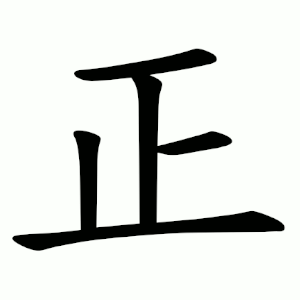正
- correct;
- upright;
- proper;
Etymology
Composed of 丁 (고무래 정) (phonetic element) and 止 (그칠 지) (semantic element – “foot/stop”).
丁 provided the sound; 止 gave the meaning of “stepping” or “movement.”
Originally meant “to march, to go on an expedition, to attack” (same origin as 征).
Later shifted to the meaning “upright, correct” via semantic extension/grafting.
Seal Script (小篆): simplified 丁’s old shape 囗 into a single horizontal stroke 一, leading to the modern shape.
Usage in Korean
It also appears in many words, including:
정의 (正義) – justice;
정월 (正月) – the first month of the lunar year;
정식 (正式) – official, formal.
Extended meanings: in mathematics and science, positive (opposite of 負 “negative”); also used for very large number units (10⁴⁰).
Words that derived from 正
- 부정(不正)–unlawfulness; illegitimacy
- 부정부패(不正腐敗)–corruption
- 수정(修正)–modification; amendment
- 정(正)–right
- 정당하다(正當하다)–fair
- 정도(正道)–right way
- 정립(正立)–development; establishment; building
- 정분합(正分合)–origin-division-union
- 정분합작용(正分合作用)–origin-division-union action
- 정상(正常)–normality; normalcy
- 정의(正義)–justice
- 정직(正直)–honesty; integrity
- 정체(正體)–identity; nature; clean handwriting
- 정체불명(正體不明)–being mysterious; being unidentified
- 정통(正統)–being authentic; very center; essence; being direct
- 진정(眞正)–sincerely; truthfully
正
바를
정
bareul
jeong
Kangxi radical:77, 止 + 1
Strokes:5
Unicode:U+6B63
Cangjie input:
- 一卜中一 (MYLM)
Composition:
- ⿱ 一 止
